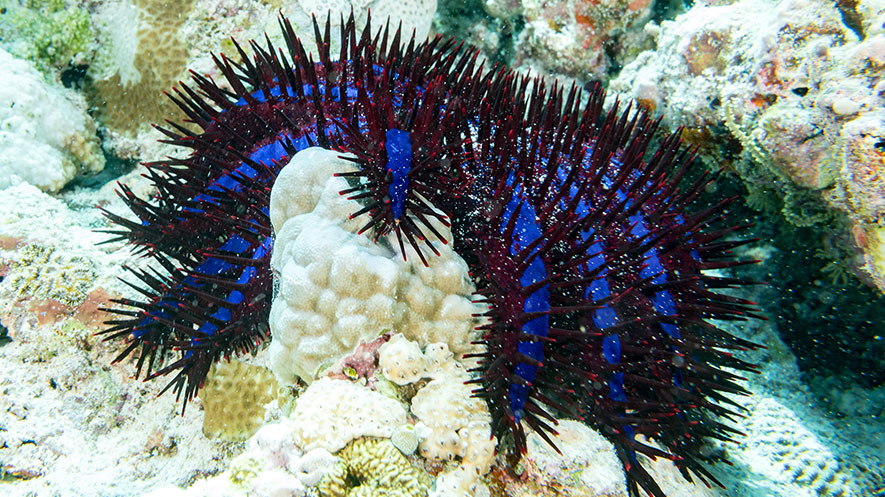On 22 January 2018, the Prime Minister of Australia, Malcolm Turnbull MP, announced a $60 million (AUD) investment to support research to secure the viability of the Great Barrier Reef and the 64,000 jobs that rely on its prosperity. The package of measures, unveiled at the Australian Institute of Marine Science (AIMS), includes a $6 million concept feasibility phase led by AIMS with CSIRO and other partners to develop a new substantive Reef Restoration and Adaptation Program.
Rising ocean temperatures as a result of climate change pose the greatest challenge to the survival of the Great Barrier Reef, compounded by poor water quality and outbreaks of the major predators of corals, the crown-of-thorns starfish. The investment will boost the number of vessels targeting crown-of-thorns starfish and the number of field officers to protect the Great Barrier Reef.
The funding will also provide incentives for farmers to reduce pollution flowing into the reef. The 18-month program builds on significant advances in coral reef science over the past decade and will develop the next generation of tools and technologies to protect the Reef and help it recover from bleaching, cyclone damage and other ongoing threats.
In an official statement, the office of the Prime Minister said, “We want to ensure its future for the benefit of all Australians, particularly those whose livelihood depends on the Reef. It is a vibrant, resilient ecosystem and one of the best-managed coral reef ecosystems in the world. While it is facing increasing threats, we intend to remain leaders in reef management. By supporting the development of innovative new reef technologies, we are also helping to cement Australia’s international reputation as a strong innovation-driven economy. This $60 million funding boost over 18 months will set in motion a major research and development (R&D) program for coral reef restoration.”
For the first time The Commonwealth of Australia will bring together key agencies to explore ways the Reef can best adapt to the changing environment to protect it for decades to come. As a critical national asset, the Reef protects Queensland’s coastal infrastructure, supports 64,000 jobs and provides $6.4 billion a year to the economy.
The plan will also ramp-up actions to help the Reef right now:
- $10.4 million for an all-out assault on coral-eating crown-of-thorns starfish. This will allow the Great Barrier Reef Marine Park Authority to increase the number of vessels targeting starfish from three to eight
- $36.6 million to further reduce pollution from water entering the Reef. This builds on our success with farmers reducing soil erosion, improving on-farm nutrient management and restoring coastal and riparian vegetation in the Reef catchments
- $4.9 million to put more field officers on the water, improving compliance, and providing early warning of further bleaching and delivering more reef and island management interventions.
“Boosting the Great Barrier Reef’s resilience so it can withstand the increasing pressures from climate change and other threats is more critical than ever,” Great Barrier Reef Marine Park Authority Chairman Dr. Russell Reichelt said. “This funding will enable us to protect live coral cover by expanding our crown-of-thorns starfish control program. Ramping up our on-water presence in the Marine Park to improve compliance with Reef-wide zoning and doing more in- park conservation work will protect Reef biodiversity.”
The Great Barrier Reef has experienced major losses of corals over the past few years, with a serious decline due to the back-to-back coral bleaching in the 2016 and 2017. In spite of these setbacks, however, many areas of the Great Barrier Reef still show resilience, which presents a window of opportunity to act now, while there is still enough diversity to preserve and restore.
“For some time the Great Barrier Reef Foundation has considered reef restoration and adaptation to be the vital missing pieces in ensuring a future for our global icon,” Great Barrier Reef Foundation Managing Director Anna Marsden said. “We’re delighted that the Australian Government has taken the major first step to launch this critical work for the Reef.
In a 22 January 2018 speech at the Australian Institute of Marine Science, the Prime Minister said, “This is the largest living creature, organism in the world, the Great Barrier Reef. It is extraordinary, and it is under challenge, but it is resilient. There is a lot of doom-saying about the Great Barrier Reef. It’s really important that we take up this challenge positively, recognizing that just as we have with so many other areas, technology and science will provide the answers. You need great scientists to do that, and of course you need the resources to support them.”





